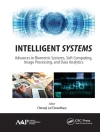Discusses the basic physical principles underlying the
science and technology of nanophotonics, its materials and
structures
This volume presents nanophotonic structures and Materials.
Nanophotonics is photonic science and technology that utilizes
light/matter interactions on the nanoscale where researchers are
discovering new phenomena and developing techniques that go well
beyond what is possible with conventional photonics and
electronics.The topics discussed in this volume are: Cavity
Photonics; Cold Atoms and Bose-Einstein Condensates; Displays;
E-paper; Graphene; Integrated Photonics; Liquid Crystals;
Metamaterials; Micro-and Nanostructure Fabrication; Nanomaterials;
Nanotubes; Plasmonics; Quantum Dots; Spintronics; Thin Film
Optics
Comprehensive and accessible coverage of the whole of modern
photonics
Emphasizes processes and applications that specifically exploit
photon attributes of light
Deals with the rapidly advancing area of modern optics
Chapters are written by top scientists in their field
Written for the graduate level student in physical sciences;
Industrial and academic researchers in photonics, graduate students
in the area; College lecturers, educators, policymakers,
consultants, Scientific and technical libraries, government
laboratories, NIH.
قائمة المحتويات
List of Contributors ix
Preface xi
1 Silicon Photonics 1
Wim Bogaerts
1.1 Introduction 1
1.2 Applications 1
1.3 Optical Functions 3
1.4 Silicon Photonics Technology 10
1.5 Conclusion 15
References 15
2 Cavity Photonics 21
J.Mørk P. T. Kristensen P. Kaer M. Heuck Y. Yu and N. Gregersen
2.1 Introduction 21
2.2 Cavity Fundamentals 22
2.3 Cavity-Based Switches 26
2.4 Emitters in Cavities 32
2.5 Nanocavity Lasers and LEDs 42
2.6 Summary 46
Acknowledgments 47
References 47
3 Metamaterials: State-of-the Art and Future Directions 53
Natalia M. Litchinitser and Vladimir M. Shalaev
3.1 Introduction 53
3.2 Negative-Index Materials 54
3.3 Magnetic Metamaterials 59
3.4 Graded-Index Transition Metamaterials 62
3.5 Transformation Optics 70
3.6 Metasurfaces 75
References 78
4 Quantum Nanoplasmonics 85
Mark I. Stockman
4.1 Introduction 85
4.2 Spaser and Nanoplasmonics with Gain 86
4.3 Adiabatic Hot-Electron Nanoscopy 118
Acknowledgments 125
References 125
5 Dielectric Photonic Crystals 133
Robert H. Lipson
5.1 Introduction 133
5.2 Fundamentals 134
5.3 Fabrication Methods and Materials 145
5.4 Applications 154
5.5 Conclusions 159
References 159
6 Quantum Dots 169
Stanley Tsao and Manijeh Razeghi
6.1 Introduction 169
6.2 Quantum Dots for Infrared Detection 175
6.3 Quantum Dot Growth 179
6.4 Device Fabrication and Measurement Procedures 184
6.5 Gallium Arsenide-Based Quantum Dot Detectors 186
6.6 Indium Phosphide-Based Quantum Dot Detectors 198
6.7 Colloidal Quantum Dots 215
6.8 Conclusion 216
References 217
7 Magnetic Control of Spin in Molecular Photonics 221
Eitan Ehrenfreund and Z. Valy Vardeny
7.1 Introduction 221
7.2 A Survey of the Magneto-Electroluminescence in OLEDs 222
7.3 Organic MEL at Small Magnetic Fields; Compass Effect 232
7.4 Magnetic Field Effect on Excited State Spectroscopies in Organic Semiconductor Films 236
7.5 Basic Quantum Mechanical Models Based on Spin-Mixing Manipulation by Magnetic Fields 246
7.6 Summary 254
Acknowledgments 255
References 255
8 Thin-Film Molecular Nanophotonics 261
Tetsuzo Yoshimura
8.1 Introduction 261
8.2 Molecular Assembling for Nanoscale Tailored Structures 262
8.3 Molecular Layer Deposition 264
8.4 Organic Multiple Quantum Dots (MQDs) 267
8.5 Self-Organized Lightwave Network 283
8.6 Proposed Applications 292
8.7 Summary 305
References 305
9 Light-Harvesting Materials for Organic Electronics 311
Damien Joly Juan Luis Delgado Carmen Atienza and Nazario Martin
9.1 Introduction 311
9.2 Photoinduced Electron Transfer (PET) in Artificial Photosynthetic Systems 313
9.3 Fullerenes for Organic Photovoltaics 323
9.4 Molecular Wires 330
9.5 Conclusions 335
Acknowledgments 335
References 336
10 Recent Advances in Metal Oxide-Based Photoelectrochemical Hydrogen Production 343
Bob C. Fitzmorris and Jin Z. Zhang
10.1 Introduction 343
10.2 Materials for PEC Hydrogen Production 346
10.3 Conclusion 362
References 363
11 Optical Control of Cold Atoms and Artificial Electromagnetism 371
Gediminas Juzeliunas and Patrik Ohberg
11.1 Introduction 371
11.2 Atomic Bose-Einstein Condensates 372
11.3 Optical Forces on Atoms 376
References 393
Index 401
عن المؤلف
David L. Andrews leads research on fundamental molecular photonics and energy transport, optomechanical forces, and nonlinear optical phenomena. He has over 300 research papers and a dozen of books to his name–including the widely adopted textbook, Lasers in Chemistry. The current focus of his research group is on optical vortices, novel mechanisms for optical nanomanipulation and switching, and light harvesting in nanostructured molecular systems. The group enjoys strong international links, particularly with groups in Canada, Lithuania, New Zealand, and the United States. Andrews is a Fellow of the Royal Society of Chemistry, a Fellow of the Institute of Physics, and a Fellow of SPIE, the international society for optics and photonics.












